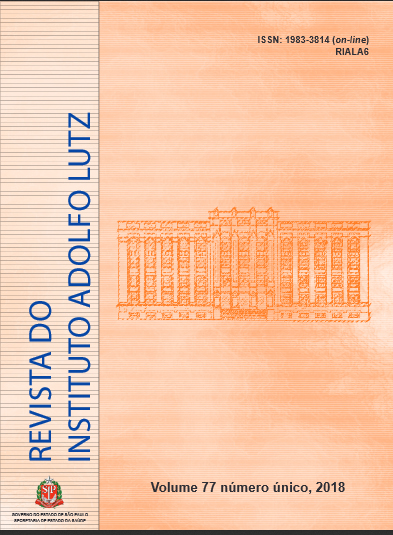Abstract
Variables related to epidemiological factors, etiologic agent, environment, vector and reservoirs seem to act in determining the different scenarios of transmission of visceral leishmaniasis (VL) in Brazil. In the state of São Paulo, VL does not present a homogeneous epidemiological pattern across all its regions, seeming to reflect a multitude of scenarios conducive to the occurrence of transmission within Paulista territory. Lutzomyia longipalpis is composed of a complex of species of which two are found in the state of São Paulo and appear to have a difference in vector capacity. It is likely that this difference is the determining factor in the characterization of the different epidemiological patterns observed in the different regions of the State. In the present study, we sought to determine the temporal and geographic distribution of Lu. longipalpis species, canine cases and human cases of VL as key elements to help characterize some scenarios of transmission of the disease and to indicate areas of greater risk for disease acquisition. The recent and unexpected occurrence of VL transmission in localities without the presence of Lu. longipalpis characterizes another new scenario, where other species of san flies can transmit Leishmania infantum to man and configuring a new challenge for public health authorities.
References
1. Domanovic D, Giesecke J. How to define an area where transmission of arthropod-born disease is occurring? Euro Surveill. 2012; 17(20):pii=20171. Disponível em: http://www.eurosurveillance.org/ViewArticle.aspx?ArticleId=20171
2. Hamilton JGC, Maingon RDC, Alexander B, Ward RD, Brazil RP. Analysis of the sex pheromone extract of individual male Lutzomyia longipalpis sandflies from six regions in Brazil. Med Vet Entomol. 2005;19(4):480-8. https://doi.org/10.1111/j.1365-2915.2005.00594.x
3. Ministério da Saúde (BR). Manual de vigilância e controle da leishmaniose visceral. Secretaria de Vigilância em Saúde, Departamento de Vigilância Epidemiológica. Brasilia (DF): Editora do Ministério da Saúde; 2006. Disponível em: http://bvsms.saude.gov.br/bvs/publicacoes/manual_vigilancia_controle_leishmaniose_visceral.pdf
4. Casanova C, Colla-Jacques FE, Hamilton JG, Brazil RP, Shaw JJ. Distribution of Lutzomyia longipalpis chemotype populations in São Paulo state, Brazil. PLoS Negl Trop Dis. 2015;9(3):e0003620. https://dx.doi.org/10.1371/journal.pntd.0003620
5. Dvorak V, Shaw J, Volf P. Parasite Biology: The Vectors. Chapter 3. In: The Leishmaniais: Old Neglected Tropical Diseases. Brusch F, Gradoni L editors; 2017. http://doi.org/10.1007/978-3-319-72386-0
6. Guimarães VC, Pruzinova K, Sadlova J, Volfova V, Myskova J, Brandão Filho SP et al. Lutzomyia migonei is a permissive vector competent for Leishmania infantum. Parasit Vectors. 2016;9:159. https://dx.doi.org/10.1186/s13071-016-1444-2
7. Secretaria de Estado da Saúde de São Paulo. Dados estatísticos da Leishmaniose Visceral de 1999 a 2017. [acesso 2018 Abr 18]. Disponivel em: http://www.cve.saude.sp.gov.br/htm/zoo/leishv_dados.html
8. Costa AIP, Casanova C, Rodas LAC, Galati EAB. Atualização da distribuição geográfica e primeiro encontro de Lutzomyia longipalpis em área urbana no Estado de São Paulo, Brasil. Rev Saúde Pública. 1997;31(6):632-3.
9. Galvis-Ovallos F, Casanova C, Pimentel Bergamaschi D, Galati EAB. A field study of the survival and dispersal pattern of Lutzomyia longipalpis in an endemic area of visceral leishmaniasis in Brazil. PLoS Negl Trop Dis. 2018;12(4):e0006333. http://dx.doi.org/10.1371/journal.pntd.0006333
10. Araki AS, Vigoder FM, Bauzer LG, Ferreira GE, Souza NA, Araújo IB et al. Molecular and behavioral differentiation among Brazilian populations of Lutzomyia longipalpis (Diptera: Psychodidae: Phlebotominae). PLoS Negl Trop Dis. 2009;3(1):e365. http://dx.doi.org/10.1371/journal.pntd.0000365
11. Motoie G, Ferreira GEM, Cupolillo E, Canavez F, Pereira-Chioccola VL. Spatial distribution and population genetics of Leishmania infantum genotypes in São Paulo State, Brazil, employing multilocus microsatellite typing directly in dog infected tissues. Infect Genet Evol. 2013;18:48-59. http://dx.doi.org/10.1016/j.meegid.2013.04.031
12. Correa-Antonialli SA, Torres TG, Paranhos-Filho AC, Tolezano JE. Spatial analysis of American visceral leishmaniasis in Mato Grosso do Sul state, Central Brazil. J Infect. 2007; 54(5): 509-14. http://dx.doi.org/10.1016/j.jinf.2006.08.004
13. Galvis-Ovallos F, da Silva MD, Bispo GB, de Oliveira AG, Neto JR, Malafronte RD et al. Canine visceral leishmaniasis in the metropolitan area of São Paulo: Pintomyia fischeri as potential vector of Leishmania infantum. Parasite. 2017;24:2. https://dx.doi.org/10.1051/parasite/2017002://
14. Reisen WK. Estimation of vectorial capacity: introduction. Bull Soc Vector Ecol. 1989; 14:39–40
15. Casanova C, Natal D, Santos FAM. Survival, population size and gonotrophic cycle duration of Nyssomyia neivai (Diptera: Psychodidae) at an endemic area of American cutaneous leishmaniasis in southeastern Brazil. J Med Entomol. 2009;46(1):42–50. https://dx.doi.org/10.1603/033.046.0106
16. Alexander B, de Carvalho RL, MacCallum H, Pereira MH. Role of the domestic chicken (Gallus gallus) in the epidemiology of urban visceral leishmaniasis in Brazil. Emerg Infect Dis. 2002;8(12):1480-5. http://dx.doi.org/10.3201/eid0812.010485
17. Kelly DW, Dye C. Pheromones, kairomones and the aggregation dynamics of the sandfly Lutzomyia longipalpis. Anim Behav. 1997;53(4):721-31. https://dx.doi.org/10.1006/anbe.1996.0309

This work is licensed under a Creative Commons Attribution 4.0 International License.
Copyright (c) 2018 Claudio Casanova
